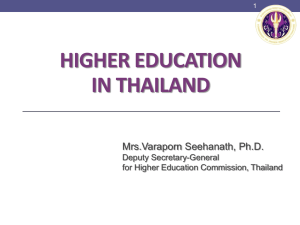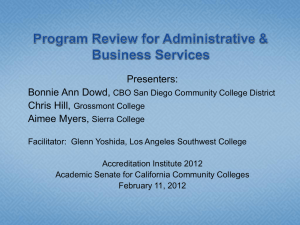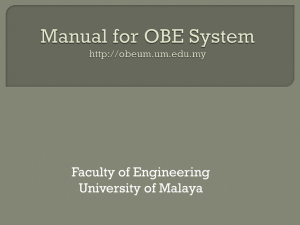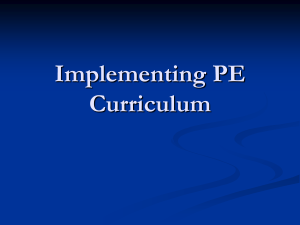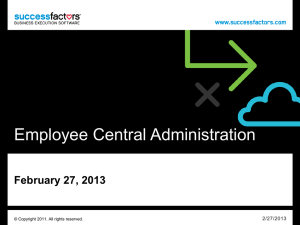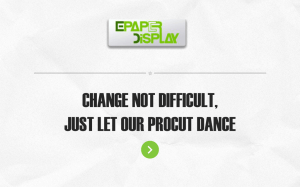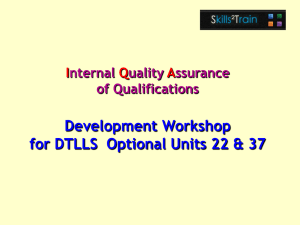University - East
advertisement
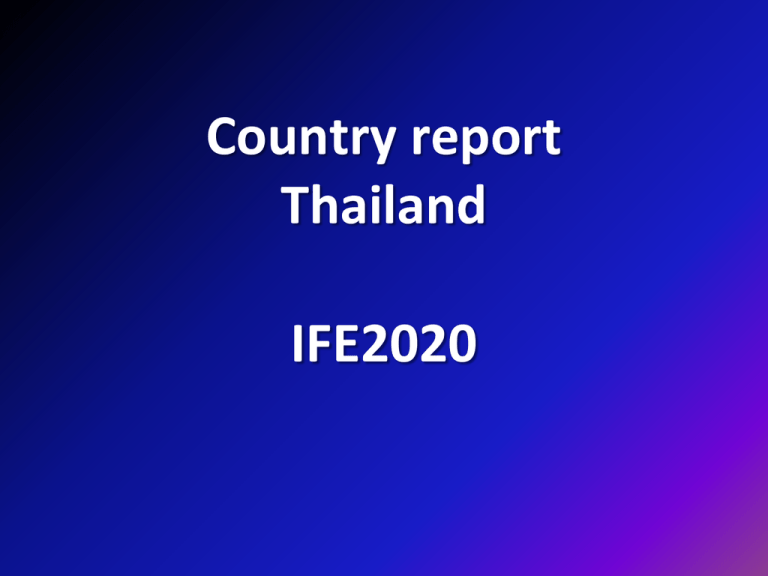
Country report Thailand IFE2020 Presentation Outline Thai Education Policy Framework Quality Assurance University Governing Framework Thai Education Policy Framework • Investing in raising quality of entire education system • Providing no fewer than 12 years of basic education • Upgrading teacher training and development • Using ICT to enhance learning efficiency • Developing quality and standard s of HEIs • Articulating higher education system with basic and vocational education • Solving existing problems in higher education • Enhancing HE and country’s competitiveness • Investing in staff development • Financing , governance, and management • Networking universities The 10th National Economic and Social Development Plan The 2nd 15-Year Long Range Plan on Higher Education • Reforming entire education system • Increasing private sector ‘s role in education provision • Building capacity of teachers, faculty, and education personnel • Providing 15 years’ cost-free education • Raising educational standards • Improving efficiency of Student Loan Fund • Providing quality education • 15-Year Free Education with Quality Project • One outstanding school for each sub district • Setting up low-cost Learning Centres • Integrating existing nat'l education networks • Teacher development and welfare • Upgrading teachers of science, mathematics, and technology Government Policy Ministry of Education’s Policy Thai Education Policy Framework Thai Education Policy’s Equation The 10th National Economic and Social Development Plan The 2nd 15-Year Long Range Plan on Higher Education Government Policy Ministry of Education’s Policy •Reform of education system •Articulation of all levels of education •Governance and financing •Teacher and education personnel development •Enhancement of education quality •Accessibility to education and life-long learning •Employability of graduates, role of real sector, and enhancement of national competitiveness From Policy to Practice Quality • 9 Centres of Excellence and 9 National Research Universities • Developing Research Assessment Exercise (RAE) • Grouping of Higher Education Institutions University Staff Development • Strategic Fellowship for Frontier Research Networks • Student and Staff Mobility Articulation of all levels of education • New Generation of Teachers Project Accessibility to Education • Student Loan Fund • 15-Year Free Education Project Information Technology • Infrastructure: Expansion of UniNet to Ned-Net and Virtual Campuses • Content: Thailand Cyber University University - Industry Linkage • University Business Incubator (UBI) • Technology Licensing Office (TLO) • Commercialization of Research: technology transfer and body of knowledge development Quality Assurance If an educational institution has not reached the standards required, the ONESQA shall submit to parent organizations on corrective measures for that institution to improve its performance within a period of time QA System IQA EQA The 1999 National Education Act Revised 2002: Chapter 6 Educational Standard and Quality Assurance Process HEIs CHE Establishing IQA systems and undertaking internal reviews ONESQA EQA is conducted by ONESQA (Public Organization) System of QA: IQA & EQA Responsible Org. Conducting external assessment every five-year cycle Development IQA is responsible by educational institutions with the involvement of academic communities and support from parent organizations Higher education institutions shall conduct self-assessment in the form of documents and evidence providing relevant information on institutions according to 9 indicators as follows: 1. Philosophy, Commitments, Objectives and Plan 2. Graduate 3. Student Development Activities 4. Research 5. Community Academic Service 6. Preservation & Promotion of Art and Culture 7. Administration and Management 8. Finance and Budgeting 9. Quality Assurance and enhancement The Relationship between the Internal Quality Assurance and the External Quality Assessment Internal Quality Assurance at institutional level Institution’s operation Institution’s Internal Assessment Self Assessment Report Feedback Feedback External Quality Assurance conducted by the Office for National Education Standards & Quality Assessment (ONESQA) Site Visits Evaluation Report Monitoring Thai Qualifications Framework TQF Learning Expectations Curriculum Standards OHEC University Fail 5 year TQF-Program Dev & improve. plan Each year TQ Quality ๑ Program Report Pass Promotion & gain benefits Degree Standards Credit Transfer Principle Program Specifications Course & Field Experience Specifications Course & Field Experience Reports Evaluation & Measurement (using 5 Learning Outcomes) Learning Process (5 Domains of Learning) Uni Council Approval OHEC Acknowledge & record in database 1. Moral and Ethics 2. Knowledge 3. Cognitive skills 4. Interpersonal skills and responsibilities 5. Numerical Analysis, Communication, and IT skills Students & Graduates Development meets learning outcomes in TQF (Qualified & satisfied graduates for workforces and society) (POD Network) Teaching Unit Facility & Environment 8 ๑ Need improvement Thai Qualifications Framework for Higher Education (TQF) Six Level of Qualifications: Advanced Diploma, Bachelor, Graduate Diploma, Master, Higher Graduate Diploma, and Doctor Five Domains of Learning 1. Moral and Ethics 2. Knowledge 3. Cognitive skills 4. Interpersonal skills and responsibilities 5. Numerical Analysis, Communication, and IT skills and in fields where they are relevant. Psychomotor skills is an additional domain for those fields such as music, nursing, physical education etc. Concept of the TQF Support Outcome Input How to Learn Methods & Strategies Source: Prof. Pirom Kamolratanakul M.D., 18 April 2009 10 University Governance University Council University Audit Committee Academic Committee President Assistance President Dean of College Vice President Dean of Faculty Director Center University Governance Research/ Graduate University Type of University Specialized/ Comprehensive University University Public Univ. • governmental unit • autonomy in academic admin through UC approval • Financial & Personnel admin. to comply with bureaucratic system • Subsidized by Government • Student Loan Fund Autonomous Public Univ. • governmental unit • full autonomy in academic admin, financial and personnel admin. through UC approval • Subsidized by Government in Blockgrant Private Univ. • Having autonomy in academic, personnel & financial admin. • some aspects to be monitored & approved by OHEC • total expenditure from their own revenue • Student Loan Fund Liberal Arts University Community College Teaching Research Providing academic services Preserving & Promotion arts & culture Relationship: Autonomous VS Government Regulation/OHEC Autonomy/Regulation OHEC Roles Type of AcademicAutonomous Personnel Financial Policy HE Financial Univ. Public Admin. Admin. Admin. standards Support University Autonomous Public Univ. Auto Public University Private Auto public universities Auto Gov. Gov. regulate regulate Community Private University College Auto Auto University Auto Partial Auto Monitoring & evaluation Non and indirect support University Structure University Council Campus Offices Office of the President Faculties/Schools Institutes/Colleges Centers Responsibilities UC responsibilities University Council Public & Autonomous Public Univ. Chairman of UC to be appointed by HM the King Ex-officio members: - University President, Chairman of Faculty Council, government agencies’ CEOs & Chairman of University Operation Promotion Board Qualified members selected from experts & appointed by HM the King Members selected from - Vice Presidents - Deans, institute directors, bureau directors, center directors - University faculties Secretary of the Council selected from Vice President Public University Private University Chairman of UC proposed by Licensee appointed by Minister of Education University President Qualified members (7-14 persons) proposed by Licensee & appointed by Minister Qualified members (not less than 3 persons) approved by OCHE Board & appointed by Minister Secretary of Council selected from university administrators Public autonomous university Private HEIs Policy formulation Quality & standard supervision Regulation set up Monitoring & Evaluation Authorized for personnel admin. To the extent approved by OHEC Board Fully authorized for personnel & financial admin. & investment Fully authorized for personnel & financial admin. & investment Future Direction Give full autonomy to public & private universities • Reduce state regulations • Focus on - policy formulation - Post auditing Strengthen governance of University Council & university management Promote good governance & management of universities
